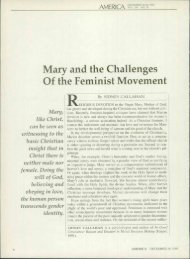Download PDF - America
Download PDF - America
Download PDF - America
Create successful ePaper yourself
Turn your PDF publications into a flip-book with our unique Google optimized e-Paper software.
Book ReviewsTheir Returnto GraceThe Party FaithfulHow and Why Democrats AreClosing the God GapBy Amy SullivanScribner. 272p $25ISBN 9780743297868Attention, all Democratic candidates,campaign managers, media consultantsand constituency organizers: If there is nota dog-eared, frequently underlined copyof Amy Sullivan’s The Party Faithful onyour bookshelf soon, please quit. Sullivan,who is the nation editor at Time magazine,writes an incisive analysis of theDemocratic Party’s inability to cultivatereligious voters and how, in a nation ofchurchgoers, this has led to their frequentexile from the halls of political power. Shecritiques the strategies that failed andsketches the outreach that has worked.This is a must read.Sullivan shows how Democrats activelylost religious voters. She describes indetail the shifting cultural forces, goingback to the Scopes trial through the countercultureof the 1960s, that created a wallbetween a devout <strong>America</strong> and theincreasingly secular, liberal elites thatshape the culture, including the culture ofpolitics. She recalls the squeamishness ofJimmy Carter’s advisors whenever hespoke of his evangelical religion. And shechronicles the refusal to let PennsylvaniaGovernor Bob Casey address theDemocratic National Convention in 1992because of his pro-life views. This historyis well known to most students of politics,but it is very well told in Sullivan’saccount.Less well known is the history ofefforts by left-leaning evangelicals andCatholics to fight secularizing trendswithin the Democratic Party. Sullivanpens an especially vivid account of the1973 meeting of evangelicals in Chicagothat published the Chicago Declaration onEvangelical Social Concern. These religiouslymotivated activists were “brimmingwith optimism” when they left Chicago;but by the end of the decade, the emergenceof evangelicals as a political powercame not from the left but from the right.“We wanted to get evangelicals politicallyengaged,” Sullivan quotes one of theChicago meeting’s organizers. “We neverexpected that the Moral Majority wouldbe the result.”In discussing the loss of ethnicCatholics from Democratic ranks,Sullivan acknowledges thecentrality of the abortionissue in alienating manyCatholic voters. She is correctin writing that “abortionrights supportersassumed that ordinaryCatholics would reject theChurch’s teaching onabortion the same waythey had with contraception”and that this assumptionproved incorrect. Theanti-Catholic bigotry ofsome abortion rights supportersis also covered; andwhile Sullivan does notprobe more deeply into the philosophicdifferences between the emerging libertarianethic of secular liberals and the traditionalethics of the Catholic Church, hertreatment of those fraught debates in the1970s is evenhanded. And her conclusionis spot-on: You can’t insult people’s religionand then wonder why they aren’t votingfor you.One mistake Sullivan makes is to placeundue emphasis on the differencesbetween the pre- and post-Vatican IIChurch. This is, sadly, a mistake made bymany Catholic historians as well but,increasingly, the continuities between thetwo are receiving the attention theydeserve. This is especially relevant whenlooking at the cultural expressions of faithand how Catholics view the world, includingthe world of politics, differently fromtheir Protestant brethren. The central actof Catholic worship, the Mass, suggests amore communal view of the world thanthat of a congregation listening to a sermon.The increased frequency of receptionof Communion that developed in the20th century dates back not to Vatican II,but to the liturgical renewal of the otherwisereactionary Pope Pius X in the firstdecade of the 20th century. Similarly, theRite of Christian Initiation of Adults hasbrought new life to countless parishes andincreased the degree of participation bylay Catholics in a variety of apostolates. Itwas Pius XII’s decision to rehabilitate theEaster Vigil liturgy that led to thisrenewed emphasis on baptism, which inturn has allowed many Catholics to liveout the words of President Kennedy:“Here on earth, God’s work must truly beour own.” The pre-Vatican II church hadall the seeds of a religiouslymotivated cultural lifethat is very different fromthe consumerist, hyperindividualisticculture thatwe call the <strong>America</strong>nmainstream.The most depressingreading for liberalCatholics is the author’srecapitulation of theclumsy way the JohnKerry campaign dealtwith the religion issue.Sullivan’s reporting skillsshine in this section asshe gets deep inside theKerry campaign to discover the decisionsthat led to the defensive, inarticulatepublic posture the rest of us saw.Compared with the aggressive andsophisticated outreach efforts of theRepublicans, the lingering anti-religiousbias of Democratic Party operatives frustratedeven grass-roots efforts to enlistCatholics and others for Kerry. EricMcFadden started one such grass-rootseffort in the swing state of Ohio, but hiseffort to get help from the official campaignwas met with the dismissive, andracist, rebuttal from Kerry officialdom,The ReviewersMichael Sean Winters has written aboutpolitics and Catholicism for The NewRepublic, Slate, The New York Times, TheWashington Post and <strong>America</strong>. He is theauthor of Left at the Altar: How theDemocrats Lost the Catholics and How theCatholics Can Save the Democrats (PerseusBooks Group, 2008).Harry S. Stout is Jonathan EdwardsProfessor of <strong>America</strong>n Religious History andchair of the Department of Religious Studiesat Yale University.Peter McDermott, a Dublin-born journalist,is associate editor of The Irish Echo in NewYork City.30 <strong>America</strong> May 5, 2008









